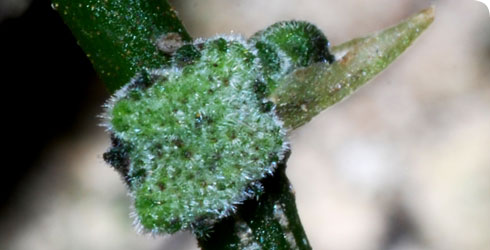Biology
This species grows on rocks or in very thin soils inside caves with very low light, and at relatively cool temperatures compared to the surrounding vegetation outside.
The male and female flowers look very different from each other and are borne in clusters that are highly modified and also look nothing like each other. In fact, it would be unlikely that most people would realise that the female flower clusters were anything to do with flowers at all!
The male flowers are borne in a compact head, with their stalks fused to form a cup-like structure that is surrounded by a number of green-white projections. The flower heads bear up to 60 minute white flowers which open explosively, spraying pollen into the air.
The female flowers are borne in a very tight compact head, with their stalks fused to form a cup-like structure surrounded by minute green teeth. The flowers are tiny - less than a quarter of a millimetre in length and are green, lack petals and have a small tuft of pale grey hairs coming from their centre.
The seeds are brown and only slightly larger than the female flowers. They are pushed out of the cup-like structure by the inflection of small tube-like structures known as staminodes.
Little is known about the pollination or dispersal of this species. Female flowers are probably wind- rather than insect-pollinated, and the seeds are probably dispersed from cave to cave by animals, although what kind of animal is unknown.
A number of interesting questions are raised by the fact that this species is known only from a handful of caves in south China, and that the temperature and conditions in caves are so different to those outside. For example, how did the species evolve in caves, and how does it get from one cave to another?
